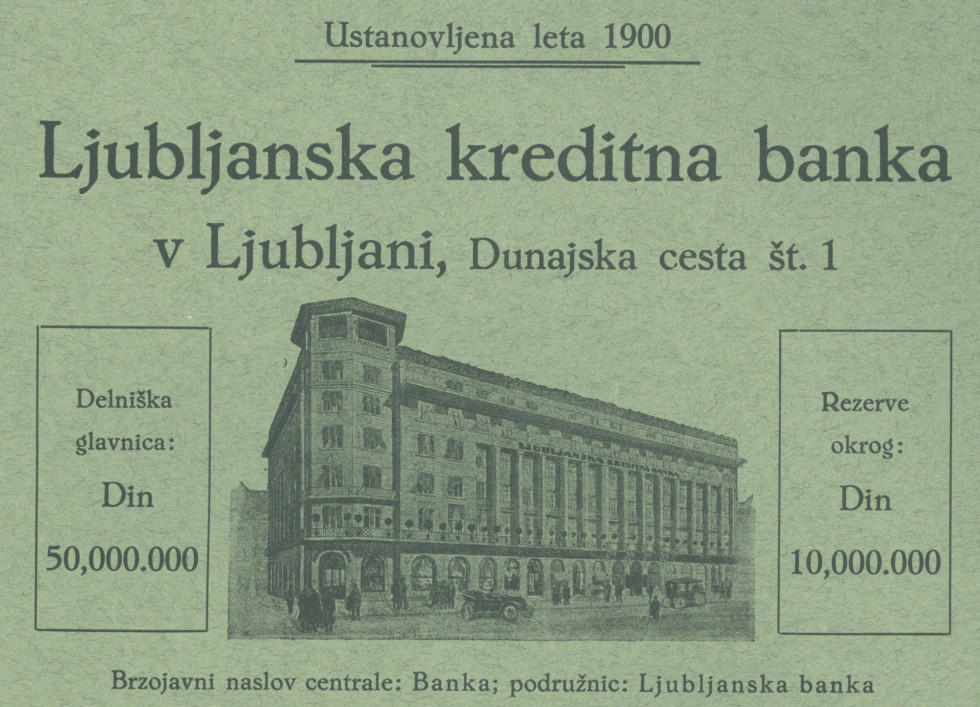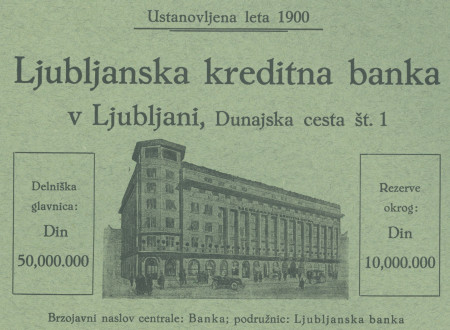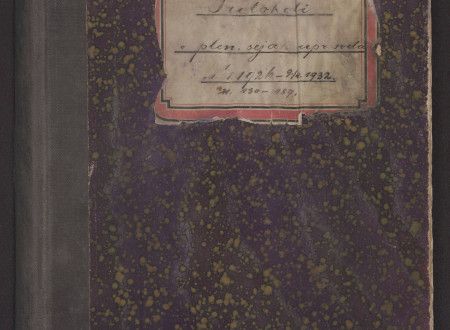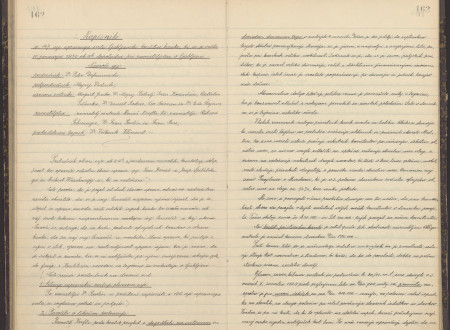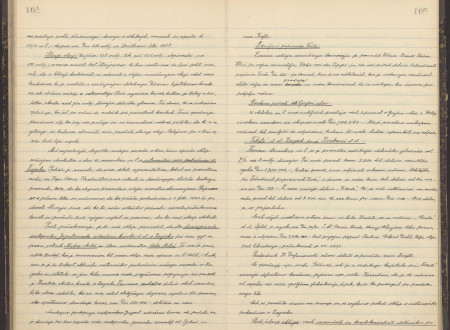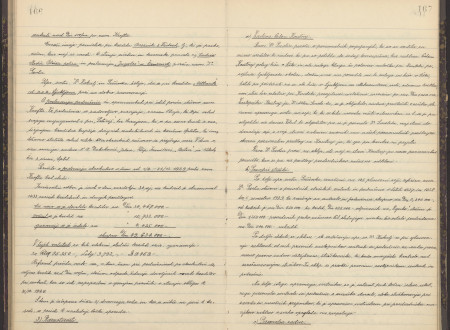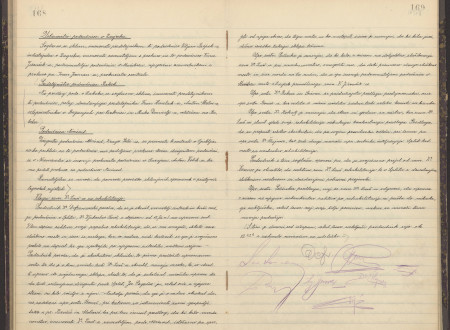Time Mirrored in the Minutes of the Ljubljana Credit Bank Authorities
Protocols on the Plenary Sessions of the Ljubljana Credit Bank Management Board 1926-1932
Presented before you is the first of our monthly archivalia set in the world of banking. Slovenians can take pride in the fact that our first banking institution – Carniolan Savings Bank – was founded as early as 1820. It was the second bank in the whole of Austrian empire and one of only a handful of banks within the wider European territory. Still, Slovenian private banking business in the form of joint-stock companies remained largely undeveloped throughout the 19th century. Credit cooperatives acted merely as a financial go-between for small-business sector by mobilising savings for loans that were then granted to farmers and craftsmen. At the turn of the 20th century there was no Slovenian bank in Ljubljana that could meet the demand of Slovenian businessmen, who were eager for domestic capital and financial services. Although banks as joint-stock companies did exist in Maribor and Prekmurje region, they operated, just like cooperative societies did, within their local communities. Carniolan Industrial Company, for example, did business with the banks in Trieste and Graz.
Ivan Hribar, Slovenia’s great patriot, politician and economist, who at the time was also the mayor of Ljubljana as well as the head of the Ljubljana branch office of the Prague insurance company Slavija, managed to convince the general head of the Živnostenská banka in Prague to help establish the Ljubljana Credit Bank. Slovenians have always looked up to Czechs in terms of their emancipation efforts, and any connection with the Czechs was thus welcomed. Slovenian political memory holds the Ljubljana Credit Bank as the first “truly Slovenian” bank. Ivan Hribar brought Czech bankers to Ljubljana and opened to Slovenian companies a path to a capital market beyond the borders of their regions, as well as helped the banking business of that time to no longer just be limited to savings. Hribar participated in the founding of the Ljubljana Credit Bank in his position as the head of the consortium, together with two other members, a Trieste-based wholesale dealer Kornelij Gorup and a solicitor Ivan Tavčar. The founding general assembly took place on August 24, 1900 at the bank in Špitalska street; at the first session of the management board Ivan Hribar was elected president of the bank and Josip Spitalsky, the then head of the Živnostenská banka in Vienna, its vice-president. Živnostenská banka was in fact considering expanding into the Slovenian territory already in 1893, when its head and the president of its management board travelled by train between Maribor and Trieste to get better acquainted with economic situation here, but decided against entering this financial market since the conditions did not seem promising enough. Now they entered it by founding the Ljubljana Credit Bank, which they got involved with partly also because of their political interest to become financial centre of Austrian Slavs. Before contributing 500,000 koronas of start-up capital, they signed an agreement claiming the right for the Vienna branch of Živnostenská banka to obtain half of all shares of the new bank, also the right to get a proportionate portion in the bank’s management board, the right to influence its business decisions and appoint its managing staff, and the right for all Vienna bank business to be conducted through their branch in Vienna.
The Ljubljana Credit Bank developed fast (by 1912 its capital was 16 times larger than the initial capital). At first it dealt mostly with deposits, but soon moved to investments, and started founding branch offices almost immediately. It participated in the founding of joint-stock and other companies and invested in them. Some of them are the Joint-Stock Company Žalec and Laški trg (1902), Jadran Bank and the First Croatian-Slavonian Savings Bank in Sisak (1905), The First Arms Factory in Borovlje and Joint-Stock Company of the Carniolan Brickworks in Trnovo near Ilirska Bistrica (1907), The First Slovenian Factory of Playing Cards (1911), and in the inter-war years also the United Paper Factories in Vevče, Goričane and Medvode Ltd. in Ljubljana, Machine Factories and Foundries Ltd. in Ljubljana, Hat Factory »Šešir« Ltd. in Škofja Loka, Chain Factory Ltd. in Lesce, Insurence Bank »Slavija« in Ljubljana, etc. The Ljubljana Credit Bank's expansion was not deterred by WWI and it found itself on solid ground in the newly created post-war state as well, even though the number of banks in Slovenia tripled by that time. Within its first ten years the bank spread its net of branch offices in Split, Klagenfurt, Trieste, Sarajevo, Gorizia and Celje, and the net was further expanded in the new state with additional branch offices opened in Maribor, Ptuj, Brežice, Črnomelj, Kranj, Zagreb, Beograd, Metković and Šibenik.
By the start of 1920s its quarters became too small and the management commissioned the construction company Tönnies and Sons to build a palace in the then Dunajska Street 1, where the bank eventually moved in May 1923; today this palace on the corner of Cankarjeva and Slovenska Street is a home to the Bank of Slovenia. In 1927, Ljubljana Credit Bank merged with Trgovska banka/Commercial Bank to create the most important Slovenian bank and the fourth bank in the territory of the whole of Yugoslavia, but it closed its branch offices outside its state borders. Although losing 60% of its capital to cover the losses suffered during the economic crisis, the bank was always ready for economic operations. Its successful operation finally came to a halt by WWII and the bank was liquidated by the end of December 1945.
Archival fonds of the National Bank of Slovenia contains more or less complete records of the Ljubljana Credit Bank. Among them there are well preserved minutes of the general assemblies of stockholders from the time the bank was founded until the outbreak of the economic crisis, there are also sessions of the management board from the mid-1920s until the end of WWII, and records on work of its executive committee, which granted loans, solved issues of pay off, appointed bank representatives to managements of supported companies, etc. for the time between WWI and 1938.
The book of »protocols on plenary sessions of the management board from January 1, 1926 to April 9, 1932« presented here as this month's archivalia, is the first among the four volumes of minutes taken by the bank's management board. While printed annual reposts, attached to notary records of the general meetings of stockholders, take us through the events in the world and domestic economy of the past year, the calligraphically recorded discussions, reflections and findings of the members of the management board are a more personal and direct testimony and witnessing of the events. Reading them can easily take us 90 years back in time. We may learn that 1929 began with a long winter, and then »abnormally summer weather caused a standstill in trade, because consumers delayed buying autumn and winter necessities«. We can see how the initial joy of anticipating a rich harvest turned into complaining due to the need to lower interest rates. Recreated before us are people with their personal initiatives, enabling us to see their reactions when faced with disappointment, or to feel their enthusiasm when conditions for the opening of a new branch office were good (followed shortly by irritation at making such a reckless decision) or their satisfaction at the closing the old branch office … Careful reviewing of the bank’s business as well as that of the companies the bank invested in, shows optimism; it was a good year and the bankers, although familiar with the American stock market crash, did not pay much attention to it; our territory managed to escape the 1930 economic crisis completely unscathed.
Aleksandra Mrdavšič


